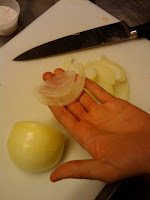Phase 2, Week 3, Day 12
Legumes was the word of the day. In English vernacular legumes means dried mature seeds. In French it means vegetables. So it definitely has different meanings, depending on to whom you are talking. There are three basic categories of legumes; kidney beans, peas, and lentils. From these groups we will be making Lentils and Cream, Hummus, and Cranberry Beans with Asparagus. Adolf demoed Hummus for us, I was amazed at how many of the students had never had Hummus before. Occasionally I am truly floored a the lack of exposure to food our class has had. I count myself lucky to have afforded the many unique culinary experiences I have had in my life.
Today was very similar to yesterday. We got moved around to different groups and I landed with a group of girls who had worked together often. They were complaining that they never got to complete all the dishes, there just never seemed to be enough time. Come to find out, they were not working their prep together. It is nearly impossible to prep all the dishes and cook them to completion in our alloted time frame. So, I took charge, gently at first. Making suggestions and saying things like "Hey, you don't need to chop that. Here, I did it for the whole table." The girls were kind of shocked. I suggested they do the same with other ingredients. Two of the three girls got with the program, one just couldn't understand the concept and kept complaining she didn't know what was going on or she was lost. I suggested if she was confused she could organize the ingredients by dish and that would help us all out. She didn't. A few minutes later the same conversation occurred. She still didn't organize the ingredients and she was still confused. I wrote her off and continued on.
One negative about all prepping together is if someone doesn't do their task correctly, the whole group suffers. This was the case today. One of the girls was to cut
bruinois celery, she like
rough chopped it. In other words the pieces were three times too big. I didn't say anything.....my bad. Another girl put all of our cranberry beans in one pot. Which was fine, except the pot was not big enough and we needed more water in it. Again, I didn't say anything.
Result: Lentils and Cream- Very good flavor, cut smaller celery, and add more cream
Cranberry Beans with Asparagus- Beans were not completely done, it was a bit bland, and I should have cut the asparagus.
Now, let's talk about the Cranberry Bean dish. I was frustrated beyond belief with the critique I was given by Ava. First off, no where in the discussion of the preparation of the dish was it mentioned to cut the asparagus. I thought it looked better to keep them long. Second, I thought the dish had flavor. I could taste the main ingredients, red wine vinegar, and salt. I had added the parmesan cheese into the dish instead of using it as a topper, but apparently that wasn't a big deal to her. So, I was utterly confused. That is until I tried my friend Jarrod's dish. He always seems to season things well. Once I tasted his dish, her comments made sense.
Without demos, we are at a disadvantage. The lack of understanding how these dishes should look and taste is a complete frustration, I'd overheard many other students express this same sentiment. So, towards the end of class I asked Ava if I could speak to her. I expressed my concern and used the example of the Cranberry Bean dish to prove my point. To my surprise, she was very understanding. We agreed that I would ask more questions about the dishes and she would be more descriptive in her critiques. She also mentioned that from watching me in the kitchen she though I had more industry experience than I actually did and it was here mistake for making the assumption that I would understand where she was coming from. Wow! To say the least, I felt pretty good about the conversation. And to top it off at the end of class, both she and Adolf addressed the issue to the class. Wow, again. Maybe things are turning around.
 |
| Cranberry Beans w/ Asparagus |
 |
| Lentils w/ BIG celery pieces |







































